The Pieniny Mountains and the Spisz region

Location and history
Pieniny is a mountain range in southern Poland and partly in northern Slovakia; The mountain range forms part of the extensive Pieniny rock belt between the Bialka Valley in Poland to the west and the Poprad Valley at St. L’oven in Slovakia.
Spisz is a historical-ethnographic land area in Poland and Slovakia. The largest part is on the Slovak side of the border. Spisz is located east of the Tatry Mountains (in the Pieniny Rock Belt), in Dunajec’s and Poprad’s river basins, between the Bialka River Valley in the west and the Poprad Valley in the east.
Pieniny Mountains
Pieniny is a separate mountain range of 35 km in length and up to 6 km in width. The chain is shared by the river Dunajec’s intersections in three parts: Pieniny Spiskie between Dursztyn and Niedzica with the highest point 88ar 883 m., Pieniny Właściwe (The Real Pieniny) between Czorsztyn and Szczawnica with the mountain Okrąglica (982 m.) as the highest point in the Korony massif Tree Crowns) as well as Małe Pieniny (The Little Pieniny), extending between Dunajec at the height of Szczawnica and the Rozdziele Pass to the east; the highest point in this last part of the mountain range is Wysoka (1050 m.).
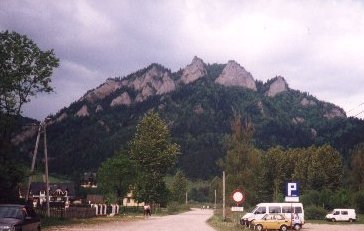
Trzy Korony (Chronicles)
The most scenically beautiful part of the chain is Pieniny Właściwe; whether this part is used in daily speech the common name Pieniny. The mountain peaks stand here as beautiful and sharp silhouettes against the sky, and the valleys often take the form of rocky gorges. The northern hillsides have a gentle slope towards the valleys, whereas the hillsides towards Dunajec (south and east), where they are made up of limestone cliffs, have a steep and effective fall from altitudes of approx. 300 m.
The Pieniny Mountains consist of limestone from Jurassic and Cretaceous times. They are distinguished by a considerable wealth of plant species, i.a. due to the fact that many plants have survived here as relics from the Tertiary and Pleistocene times. The original flora and landscapes make Pieniny an attractive tourist area.
The central part of the mountain range is now interpreted as Pieniny National Park; there is a similar park on the Slovak side of the border.
Tourist attractions
Dunajec
The largest river in the area is Dunajec. Over a distance of 8 kilometers, the river runs through Pieniny Spiskie, later through the artificial Czorsztyn lake and finally via seven curves along the so-called Pieniny intersection (Przełom Pieniński), where it creates a gorge with steep, almost vertical cliff walls that reach 500 meters in height.
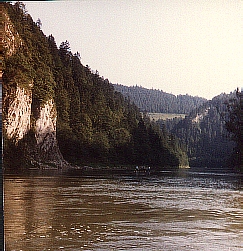
The fall of the river between Kąty (where the intersection begins) and Krościenko is 45 meters.
The Dunajec River has a length of 251 km and is a tributary to Wisła. Within the Pieniny area, many smaller streams flow into the river. These streams have the character of mountain streams with a significant fall and rapid passage. The amount of water varies greatly depending on the season. Water temperature is low: 6.5 – 14 degrees C in summer.
In the Pieniny region, there are 17 fish species in the river.
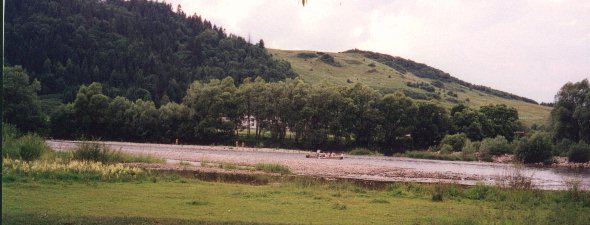
Czorsztyn Lake
Lake Czorsztyn now forms an essential element of the Pieniny countryside. It represents one of the most significant investments in hydro energy in Poland and was completed after almost 20 years of construction work.
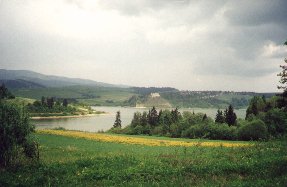
The main element of the plant is the artificial lake (water reservoir) created by the damming of the water in Dunajec through soil and concrete dams in connection with hydropower plants. Due to the dams, Dunajec has expanded into an elongated, artificial lake called Lake Czorsztyn. The lake extends between Dębno in the west and Niedzica in the east. The main dam is 404 meters long and 56 meters high. The lower embankment at Sromowce is 460 m long and 11 m high. The length and maximum width of the lake are respectively. 12.5 and 1.7 km. The area of the lake is normally 1051 ha (maximum 1226 ha).
Despite many protests and resistance along the way, the project was completed in 1996. Already during the extensive flood disaster in Poland in July 1997, the dam and water reservoir showed their value, protecting the environment from the worst consequences of the flood.
In the future, several tourist facilities are planned along the shores of the lake.
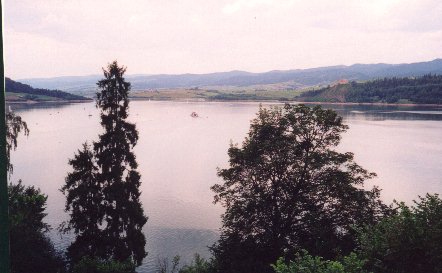
Mineral water springs
A major tourist attraction in the area is the mineral springs at Szczawnica and Krościenko. The carbonated water has, among other things, content of iodine and bromine. The spring water is used in the treatment of respiratory disorders, allergic diseases, emphysema, cataracts in the digestive organs, etc.
Resettlement.
The earliest recent settlement in the Polish Pieniny area is connected with the monastery founded by Prince Kinga in 1280 under the Klara order in Stary Sącz. Somewhat earlier came the castle of Pieniny, whose ruins can still be seen on the northern slope of the mountain massif Trzy Korony. The likely founder of the castle is Kinga (later Saint Kinga), who was married to Prince Bołeslaw the Bluebird. The time for this defense can be compared to the year 1257, when Bolesław gave the Kinga Sącz area and 1287, the year of the Tatars’ attack. The Klara order founded the village of Sromowce Wyżne, mentioned in a document of 1323.
At the end of the 13th and the beginning of the 14th century. there was an increasingly intensive settlement on the other side of Dunajec. The colonization of these areas occurred mainly by summoned Germans, the so-called Spisz Saxons; they populated several villages, many of them still with German-sounding names, such as: Dursztyn, Falsztyn, Frydman, Krempachy, and Cervený Klástor and Lechnica – the last two in present-day Slovakia.
At the transition between the 14th and 15th centuries. immigrated a larger number of people from Volhynia – beyond the Carpathians. It was a shepherd people who, after a nomadic existence, began to settle down. The new migrants populated the higher-lying areas; here the soil was poorer and only poorly suited for agricultural use. In turn, these provided their own opportunity to continue living with livestock breeding and herding. In this way, villages such as Jaworki, Szlachtowa, Lipnik, Jarabina, Kamienka and Stránany, most of them in present-day Slovakia.
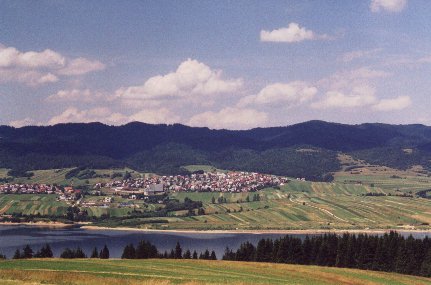
View from south across Lake Czorsztyn towards the village of Maniowy
Different types of tourism and activities that are possible in Pieniny:
Raft Sailing:
The starting point for sailing in Sromowce Wyżne-Kąty is open every day from May 1st to October 31st.
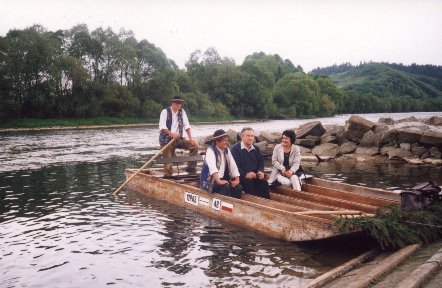
Dunajec with raft sailing
Tickets for renting raft vessels are sold on a regular basis; advance booking is not required. The duration of the sailing depends on the choice of destination and the water level in Dunajec, but is otherwise between 2 and 3 hours. The end stations are either Szczawnica Niżna or Krościenko. If arriving by car, it is best to leave the car in the parking lot of Szczawnica, Krościenko or Sromowce-Kąty. From Krościenko or Szczawnica it is easy to get back to the starting point in Sromowce-Kąty with one of the buses traveling on shuttle on this route. That way you do not have to worry about how to get back to the car, but can concentrate admire the beautiful views and relax. Moreover, it also protects Pieniny National Park by limiting the number of cars passing through the area.
Hiking tourism and bike paths:
Hiking:
Blue path : Czorsztyn – Pavilion at the entrance to Pieniny National Park – Setter’s cabin at Polana Majerz – Macelak – Trzy Kopce (1 hour) – Szopka pass (1.5 hours) – Trzy Korony – Polana Kosarzyska (2.5 hours) – Kinga’s sponsor – Bajków Gronik (3 1/4 t.) – Polana Burzana (3 3/4 t.) – Czertezik (4 t.) – Sosnów Pass (4 1/4 t.) – Sokolica – (transport) – pavilion at the entrance to the national park – Szczawnica, a place for timber rafting (5 1/2 t.)
Yellow path : Krościenko – Bajków Gronik (1 1/4 t.) – Szopka Pass (1 3/4 t.) – Szopczański Gorge – Sromowce Niżne (2 3/4 t.)
Green path : Sromowce Niżne – Polana Kosarzyska (1 1/2 t.)
Green path : Krościenko – Kras – Sosnów Pass (1 hour)
Green path : Krościenko – Polana Burzana (1 t.) – Czertezik (1 1/4 t.)
Green path : Czorsztyn – Zamek Czorsztyn (1/4 t.)
Red path : Sromowce Wyżne-Kąty, point of departure for timber fleet – Trzy Kopce (1 1/4 t.)
Red path : Szczawnica, timber docking point – pavilion at the entrance to the national park – (transport) – border crossing – Lesnický potok (1/4 t.) – Huta (1 1/2 t.) – Cervený Klástor (2 1/4 t.) – Cerla (3 t.) – Plasná (4 t.) – Well’cow Lipník (5 h.). On the route Lesnický potok – Cervený Klástor the route is laid as didactic-scientific hiking trail (There are 12 boards with descriptions in Polish and English)
Blue path : Lesnický potok – pavilion at the entrance to the national park – Lesnica (1/2 t.) – Vyhliadka (1 t.) – Cerla (1 1/2 t.) – Cervený Klástor (2 t.)
Yellow path : Huta – Vyhliadka (3/4 h.)
Green path : Lesnica – Plasná (1 t.) – Haligovské skaly – Haligovce (1 3/4 t.)
BIKE PATHS:
1. Szczawnica Niżna – Droga Pienińska – border crossing – Lesnický potok – Cervený Klástor (10.5 km)
2. Niedzica – Kacwin – Łapszanka – Rzepiska – Łapsze Wyżne – Dursztyn – Niedzica (42 km, approx. 4 h. 30 min.). The route is relatively difficult.
3. Krościenko – Snozka Pass – Czorsztyn – Sromowce Wyżne – Lysa – Cervený Klástor – Droga Pienińska (42 km). The route is easy and follows the Dunajec intersection very beautifully.
4. Szczawnica – Schronisko Orlica – Małe Pieniny – Obidza – Jaworki – Szczawnica. (35 km, approx. 4 h.) The route is relatively difficult.
The bike paths often coincide with the hiking trails, so you need to pay special attention when traveling on the trails.
kayaking Route
Boating at Dunajec ::
Nowy Targ – Frydman – Sromowce – Przełom Pieniński – Szczawnica – Krościenko.
(Sailing on a mountain river associated with certain natural difficulties. The length of the route is 50 km. Time spent: 2 days. The best times are May and June. for the Body of Christ’s Day (Thursday after Pentecost)
Towns and villages in the Polish part of Pieniny:
Czorsztyn, Dursztyn, Falsztyn, Frydman, Grywałd, Haluszowa, Jaworki: Szczawnica, Jurgow, Kluszkowce, Krempachy, Krościenko nad Dunajcem , Łapsze Niżne, Łapsze Wyżne, Maniowy, Niedzica, Nowa Biała, Szlachtowa: Szczawnica, Sromowce Niżne, Sromowce Wyżne, Szczawnica , Tylmanowa.
Czorsztyn
Distances in km Nowy Targ 25 km w., Krościenko 10 km.)
A small village located on Lake Czorsztyn. On a ridge stands the ruins of a castle from the 14th century. The castle of Czorsztyn was bordered in the medieval Polish state, especially from the middle of the 15th century, when a castle was built on the other side of Dunajec, in Niedzica, which belonged to Hungary.
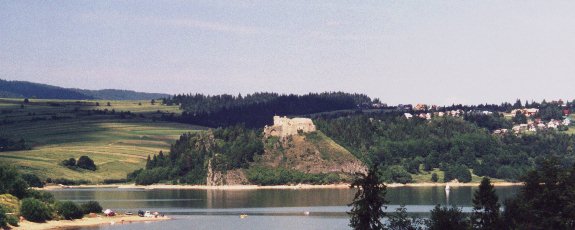
View of the ruins of the castle at Czorsztyn
Frydman
Distances in km Nowy Targ 12 km west, Krościenko 20 km island).
A village whose history dates back to the 11th century. The village has retained its medieval building plan. There is one of the oldest churches in the area, a Gothic church with later additions in Rococo style. In the 18th century. the octagonal godmother’s chapel was built, whose decorations are considered the most interesting example of rococo in this part of Spisz.
In Frydman you can see the Castle from the 17th century. – a building that is a middle ground between a castle and a residence. After many redevelopments, the building has lost its original character and now serves ordinary habitation. Next to the Castle are very spacious cellar rooms in which the original Hungarian owners stored Hungarian wine. The basements are on two floors with a width of 6 meters and a height of 3 meters; the length exceeds 90 meters. Unfortunately, the basement rooms are now in very poor condition.
Krempachy
Distances in km Nowy Targ 10 km NW, Krościenko 26 km island).
A village with two parallel streets and a central square where the church stands. In the middle of the village, the stream Przykopa runs. There are two churches from respectively. the 16th and the 18th. Outside the inhabited area are a number of barns that form almost an independent street. Also interesting are the special potato cellars still in use; they are excavated in the Białka River’s steep wide and covered with solid wooden limbs.
Nowa Biała
Distances in km Nowy Targ 9 km nv., Krościenko 27 km island).
Large village where the medieval town plan is preserved; central is a square where the roads meet. The village is located on the old royal trade route between Hungary and Poland and in ancient times had different rights, including. for storage of merchandise. You drive into the village on a street where there are mainly barn buildings, only then to the village center, where you find two parallel streets with residential buildings that are close together. The houses are usually walled and stand close to each other. They all face the gables and have large gates in which traditional-style doors are carved. In the middle of the village stands the church from the 18th century.
Sromowce Niżne (about 2 km. island of Niedzica); Sromowce Wyżne (approx. 5 km island of Niedzica)
Two villages, which at the beginning of the 16th century. was one settlement. Today, the villages are first and foremost known because this is where the traditional sailboat sailing on Dunajec begins. Ca. 700 timber fleets transporting tourists down Dunajec originate in these villages. In Sromowce Niżne there is a wooden church from the 17th century.
Niedzica
Distances in km Nowy Targ 31 km NW, Krościenko 23 km NE).
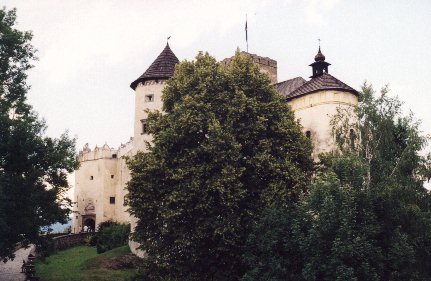
Castle of Niedzica

Niedzica is a village partly located on Lake Czorsztyn. Between 1320 and 1330, the Spisz tomb of the Hungarian family Berzevics built a castle here (called Zamek Dunajec) to protect the trade route between Hungary and Poland. The castle remains today in almost unchanged form. Close to Niedzica, a dam was built over Dunajec, a building completed in late 1990’s. The artificial lake in front of the dam has made the area even more attractive to tourists, while reducing the risk of flooding. There are many water sports opportunities associated with the lake.
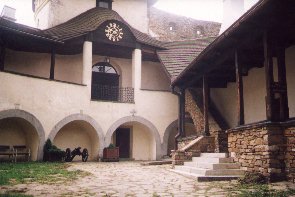
From the castle of Niedzica
Accommodation
links
Pieniny (in Slovak, Czech, Polish, English, German, French, Dutch and Hungarian)
Pieniny National Park (Danish)
Pieniński Park Narodowy – in Polish, English and German
Translated into English by Google Translate. Spangshus.dk accept no liability for any errors or omissions in translation.
Map
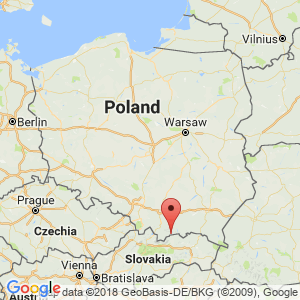
Search
Most used tags
churches (205) Castles (86) Monasteries (79) Town walls (74) Lakes (71) Town halls (67) Rivers (65) Castles1 (62) Mansions (55) Museums (51) Regional museums (38) Town gates (36) Abbey churches (35) Castle ruins (30) Cathedrals (26) Forests (25) Health resorts (24) Mounds (23) Water sports (23) National parks (22)Click for all tags
Denne side er også tilgængelig på dansk. This page and contents is (c) Copyright 2018- www.spangshus.dk. Based on Inviator software by ISCA Software